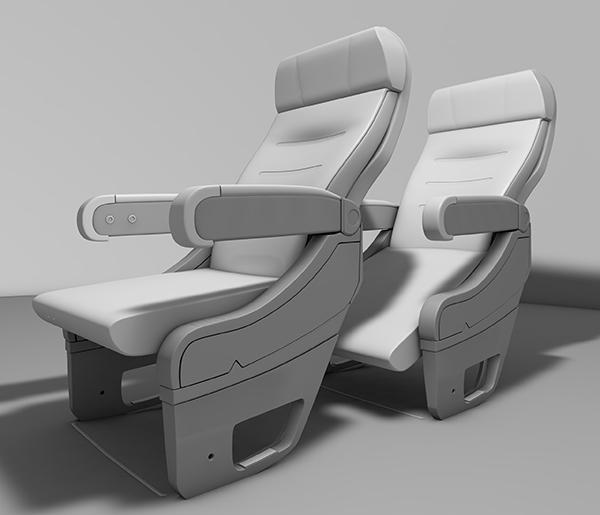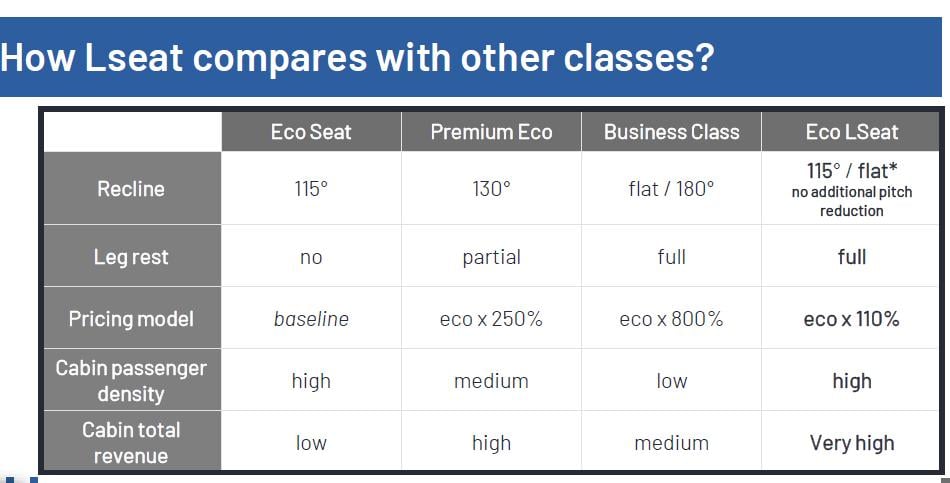
As cabin seat innovators look for ways to make economy class more comfortable for passengers and more profitable for airlines, new seat designs are attracting attention.
One entrepreneur believes his economy class seat design—the Lseat—is just the right fit for airlines looking to fill denser economy cabins in the COVID-19 era.
The Belgian-patented Lseat switches from sitting to sleeping position, by lowering the seat and using space underneath the seat in front to recline, for a small mark-up on economy fare. As the pitch between seat rows stays the same, the company said the airline “does not suffer any loss in passenger cabin density while enjoying increased revenue and increased services.”
Lseat founder and CEO Yves Hendrickx believes his Lseat will turn economy class into the “most profitable class for airlines,” which he said will be critical as carriers search for new ways to attract customers to fill aircraft.
Lseat company said current economy seats are designed to remain in a sitting position, which makes it uncomfortable for passengers to sleep, especially on flights longer than four hours.
The Lseat is designed so that the front part of the cushion slides down and a leg and feet holder extend below the seat in front. The seat is said to offer a reclining position for a comfortable sleep, while distance and pitch between the seat rows remains unchanged. No power assistance or cabin crew assistance is required.

Credit: Lseat
“Sleep mode won’t disturb your neighbors; they will still have the same pitch and leg room,” Hendrickx said, adding that even when fully extended, Lseat stays at 115 degrees (the same recline that economy seats offer now) with no additional pitch reduction, keeping the same cabin passenger density and recline as regular economy seats.
Hendrickx told ATW he got the idea for the Lseat at the end of last year in pre-COVID times when flying economy on uncomfortably long flights. “I thought, there is room beneath the seat; why can’t I use that? It is ideal to lower the front part of the seat.” He said the pandemic has accelerated the need for this kind of solution as airlines strive to fill their planes again.
“Innovations on aircraft are usually focused on first- and business-class, and nobody is focused on the economy class, which has the biggest numbers on the aircraft,” said Hendrickx, who is also an engineer, pilot and aviation specialist. “The numbers are there to make airline income much bigger. Now with COVID, it is becoming harder and harder to fill the business class. On the other side, in economy class, passengers are still anxious to travel.”
He said that Lseat would cost a passenger approximately 10% more than a regular economy ticket.
Lseat advisory council member Mathieu Pauwels told ATW: “Research shows that 75% of travelers would pay up to $50 and even up to $100 more for a comfortable seat.”
Hendrickx added: “Maybe it’s ambitious, but we can say that we invented the eco-business class.”
According to the company, the Lseat can be supplied as new or as retrofit on a range of an aircraft’s existing seats. A retrofit kit converts existing seats into Lseat, developed on demand and tailored for aircraft in service. The kit can be engineered for any type of commercial aircraft and has an “out-of-the-box setup” that takes no additional AOG time. “It becomes fast, cheap and easy to convert from eco seats to the Lseat.” The company estimates the return on investment for airlines to be as low as 12 weeks.
Lseat production is ongoing and engineering and certification are in progress, which Hendrickx predicts could be as early as 2021.
“We are working on certification and we are in good hands for that because we are working with SONACA—a large hardware supplier for Airbus and Boeing,” he said. “As we expect needs to reach high volumes, several high-capacity partners will be involved, among them former Dutch aircraft manufacturer Fokker.”
For information on Lseat, visit https://lseat.eu/
